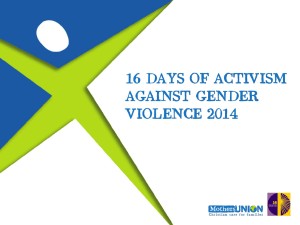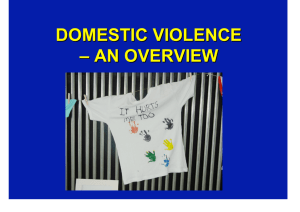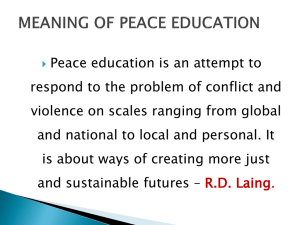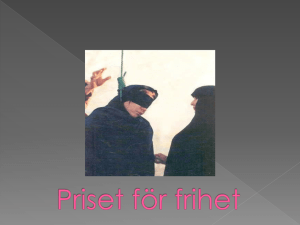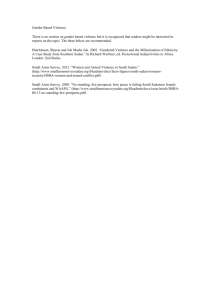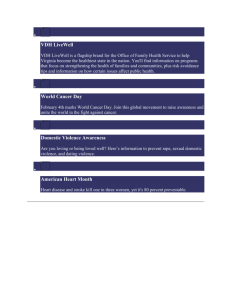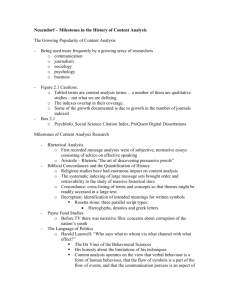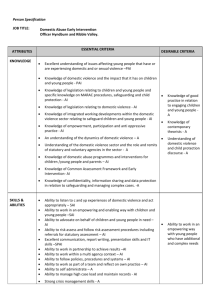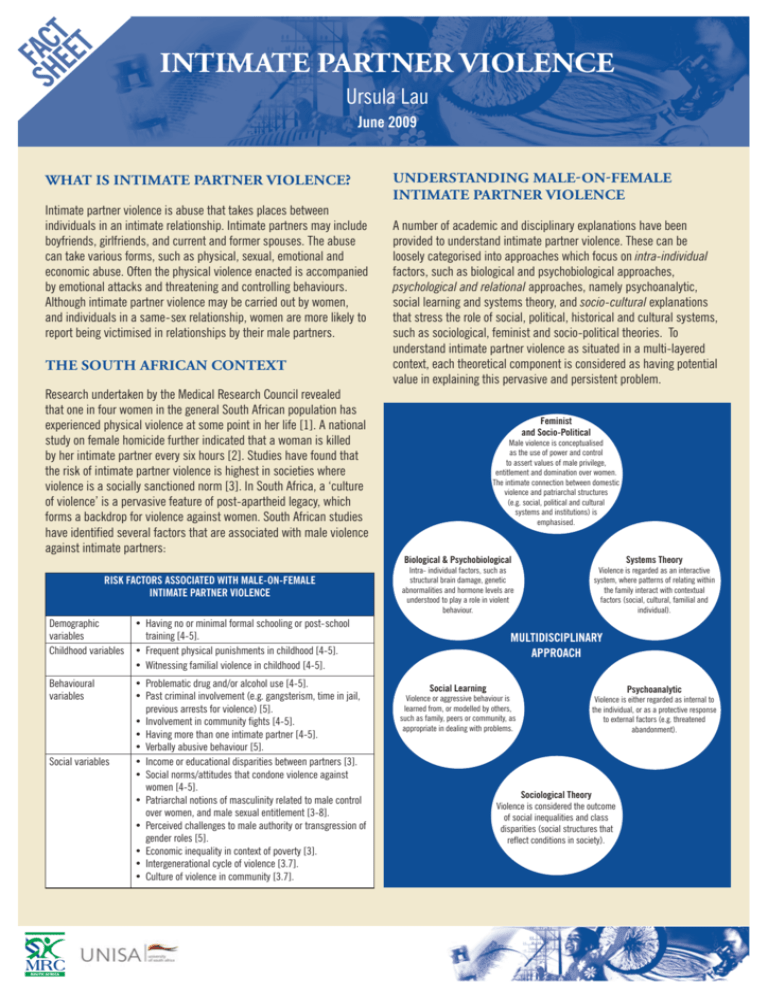
INTIMATE PARTNER VIOLENCE
Ursula Lau
June 2009
WHAT IS INTIMATE PARTNER VIOLENCE?
Intimate partner violence is abuse that takes places between
individuals in an intimate relationship. Intimate partners may include
boyfriends, girlfriends, and current and former spouses. The abuse
can take various forms, such as physical, sexual, emotional and
economic abuse. Often the physical violence enacted is accompanied
by emotional attacks and threatening and controlling behaviours.
Although intimate partner violence may be carried out by women,
and individuals in a same-sex relationship, women are more likely to
report being victimised in relationships by their male partners.
THE SOUTH AFRICAN CONTEXT
Research undertaken by the Medical Research Council revealed
that one in four women in the general South African population has
experienced physical violence at some point in her life [1]. A national
study on female homicide further indicated that a woman is killed
by her intimate partner every six hours [2]. Studies have found that
the risk of intimate partner violence is highest in societies where
violence is a socially sanctioned norm [3]. In South Africa, a ‘culture
of violence’ is a pervasive feature of post-apartheid legacy, which
forms a backdrop for violence against women. South African studies
have identified several factors that are associated with male violence
against intimate partners:
RISK FACTORS ASSOCIATED WITH MALE-ON-FEMALE
INTIMATE PARTNER VIOLENCE
UNDERSTANDING MALE-ON-FEMALE
INTIMATE PARTNER VIOLENCE
A number of academic and disciplinary explanations have been
provided to understand intimate partner violence. These can be
loosely categorised into approaches which focus on intra-individual
factors, such as biological and psychobiological approaches,
psychological and relational approaches, namely psychoanalytic,
social learning and systems theory, and socio-cultural explanations
that stress the role of social, political, historical and cultural systems,
such as sociological, feminist and socio-political theories. To
understand intimate partner violence as situated in a multi-layered
context, each theoretical component is considered as having potential
value in explaining this pervasive and persistent problem.
Feminist
and Socio-Political
Male violence is conceptualised
as the use of power and control
to assert values of male privilege,
entitlement and domination over women.
The intimate connection between domestic
violence and patriarchal structures
(e.g. social, political and cultural
systems and institutions) is
emphasised.
Biological & Psychobiological
Intra- individual factors, such as
structural brain damage, genetic
abnormalities and hormone levels are
understood to play a role in violent
behaviour.
Systems Theory
Violence is regarded as an interactive
system, where patterns of relating within
the family interact with contextual
factors (social, cultural, familial and
individual).
Demographic
• Having no or minimal formal schooling or post-school
variables
training [4-5].
Childhood variables • Frequent physical punishments in childhood [4-5].
• Witnessing familial violence in childhood [4-5].
Behavioural
variables
Social variables
• Problematic drug and/or alcohol use [4-5].
• Past criminal involvement (e.g. gangsterism, time in jail,
previous arrests for violence) [5].
• Involvement in community fights [4-5].
• Having more than one intimate partner [4-5].
• Verbally abusive behaviour [5].
• Income or educational disparities between partners [3].
• Social norms/attitudes that condone violence against
women [4-5].
• Patriarchal notions of masculinity related to male control
over women, and male sexual entitlement [3-8].
• Perceived challenges to male authority or transgression of
gender roles [5].
• Economic inequality in context of poverty [3].
• Intergenerational cycle of violence [3.7].
• Culture of violence in community [3.7].
Social Learning
Violence or aggressive behaviour is
learned from, or modelled by others,
such as family, peers or community, as
appropriate in dealing with problems.
Psychoanalytic
Violence is either regarded as internal to
the individual, or as a protective response
to external factors (e.g. threatened
abandonment).
Sociological Theory
Violence is considered the outcome
of social inequalities and class
disparities (social structures that
reflect conditions in society).
WHAT SOUTH AFRICAN STUDIES HAVE
FOUND ABOUT MALE PERPETRATORS OF
INTIMATE PARTNER VIOLENCE
• Men’s use of violence against their intimate partners is associated
with witnessing violence in the family of origin, problematic drug
and/or alcohol use, and the involvement in conflicts outside the
relationship context [4-5].
• Men are often socialised into violence. Aggressive behaviour may be
learned in the family, from peers and in the community or cultural
context (e.g. “beating a woman is part of my culture”) [6].
• Men who are violent towards their partners tend to adopt rigid,
stereotyped views on how women and men should behave (e.g.
a man is the “head of the household”, “a woman must obey her
husband”) [8-9].
• Violence is often enacted when their partners or wives are seen to
violate these gender norms [3.5].
• Feelings of powerlessness at not being able to meet social
expectations of manhood (“successful masculinity”) due to poverty,
unemployment or lack of education have often been put forward by
men to explain their violence [6.8].
• Violence often contains an emotional component (feeling a “loss of
control”), as well as an instrumental purpose (“having control” over
another) [9].
RECOMMENDATIONS FOR PREVENTION
[10-11]
Initiatives to prevent intimate partner violence at the individual,
psychological/ relational and socio-cultural levels include:
INDIVIDUAL
PSYCHOLOGICAL
AND RELATIONAL
SOCIO-CULTURAL
• Programmes to reduce antisocial and aggressive behaviour in
children and adolescents.
• Individual counselling, psychotherapy and social-casework with
victims and perpetrators of violence.
• Treatment and rehabilitation of individuals to prevent revictimisation (e.g. shelters for victims, anger management for
perpetrators).
• Parent and family-based programmes to prevent child maltreatment
and to develop positive parenting skills.
• Home visitation programmes.
• School-based programmes to change gender norms and attitudes
and to prevent dating violence.
• Life-skills and mentoring programmes.
• Community-based programmes that use participatory methods
to change gender norms, participatory training on HIV risk and
prevention, self-reliance skills, rape prevention programmes for
women (e.g. self-protection skills), targeting of boys and men
as vulnerable groups, and utilising men to facilitate change in
communities.
• Public awareness campaigns to dispel myths about intimate partner
violence, influence public opinion, and encourage political will.
• Human rights advocacy to foster gender equality and empowerment
of women, promote legal reform, strengthen criminal justice
responses and improve safety of physical environments.
REFERENCES
1. Jewkes, R., Penn-Kekana, L., Levin, J., Ratsaka, M. &
Schreiber, M. (2001). Prevalence of emotional, physical,
and sexual abuse of women in three South African provinces.
South African Medical Journal, 91, 421-428.
2. Mathews, S., Abrahams, N., Martin, L.J., Vetten, L., van der Merwe,
L. & Jewkes, R. (2004). “Every six hours a woman is killed by her
intimate partner”: A national study of female homicide in South
Africa. MRC Policy Brief, 5. Cape Town: Medical Research Council.
3. Jewkes, R. (2002). Intimate partner violence: Causes and
prevention. Lancet, 359 (9315), 1423-1429.
4. Abrahams, N., Jewkes, R., Laubscher, R. & Hoffman, M. (2006).
Intimate partner violence: Prevalence and risk factors for men in
Cape Town, South Africa. Violence and Victims, 21 (2), 249-265.
5. Abrahams, N., Jewkes, R., Hoffman, M. & Laubsher, R. (2004).
Sexual violence against intimate partners in Cape Town: Prevalence
and risk factors reported by men. Bulletin of the World Health
Organisation, 82(5), 330-337.
6. Wood, K. & Jewkes, R. (2001). ‘Dangerous’ love: Reflections on
violence among Xhosa township youth. In R. Morrell (Ed.), Changing
men in Southern Africa (pp. 217-336). Pietermaritzburg: University
of Natal Press.
7. Abrahams, N., Jewkes, R. & Laubscher, R. (1999). “I do not believe
in democracy in the home”: Men’s relationships with and abuse of
women. Technical Report. Cape Town: Medical Research Council of
South Africa.
8. Boonzaier, F. & de la Rey, C. (2004). Woman abuse: The construction
of gender in women and men’s narratives of violence. South African
Journal of Psychology, 34(3), 443-463.
9. Lau, U. (2008). An exploration of men’s subjective experiences
of their violence toward their intimate partners. Unpublished
Master’s thesis, University of the Witwatersrand, Johannesburg.
10. Harvey, A., Garcia-Moreno, C. & Butchart, A. (2007). Primary
prevention of intimate-partner violence and sexual violence:
Background paper for WHO expert meeting. Geneva: World Health
Organization.
11. World Health Organization. (2004). Handbook for the
documentation of interpersonal violence prevention programmes.
Geneva: World Health Organization.
CONTACT DETAILS:
Institute for Social & Health Sciences
University of South Africa
P.O. Box 1087, Lenasia, 1820, South Africa
Tel: +27 11 857 1142/3 | Fax: +27 11 857 1770
Email: Lourilc@unisa.ac.za
Website: http://www.unisa.ac.za/dept/ishs/index.html
MRC-UNISA Crime, Violence and Injury Lead Programme
P.O. Box 19070, Tygerberg, 7505, South Africa
Tel: +27 21 0534 | Fax: +27 21 938 0381 |
E-mail: Annelise.Krige@mrc.ac.za
Website: http://www.mrc.ac.za/crime.crime.htm


